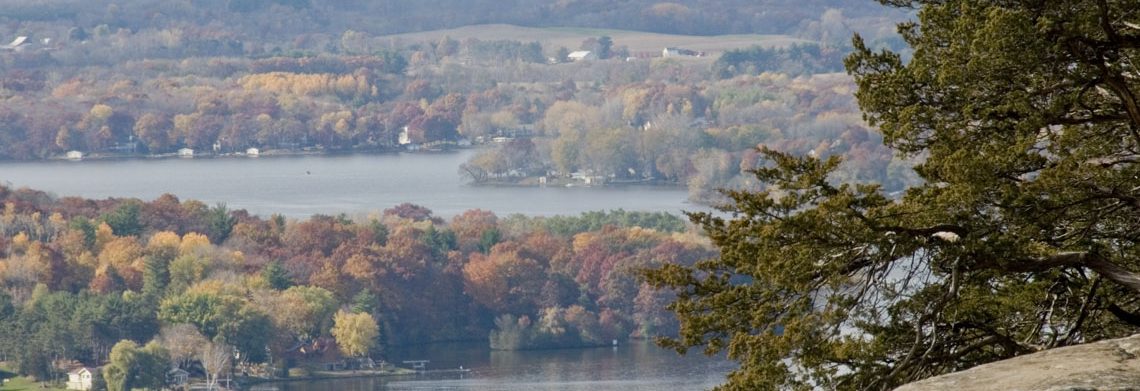Oak Barrens
Counties:Adams, Burnett, Columbia, Dane, Dunn, Grant, Iowa, Jackson, Juneau, Marquette, Monroe, Pepin, Pierce, Polk, Portage, Richland, Sauk, Trempealeau, Waushara |
|
Description:
Wisconsin oak barrens are a type of ire-dependent, fire-maintained savanna community. They are characterized by open, rolling hills with a sparse tree canopy and a diverse array of grasses and wildflowers. These ecosystems occur in areas with thin, dry soils that are not conducive to the growth of large trees, but support a wide variety of other plant life. Oak barrens are typically found on the tops of hills or on the sides of steep slopes, where the soil is exposed to the sun and wind, creating conditions that are unfavorable for trees but favorable for grasses and other herbaceous plants.
The oak trees that give these ecosystems their name are typically small and scrubby, and grow in scattered patches throughout the barrens. Other common tree species found in oak barrens include hickory, maple, and basswood. The grasses and wildflowers that grow in oak barrens are adapted to the dry, sunny conditions and include species such as big bluestem, Indian grass, and wildflowers like goldenrod and asters.
Historically, the Oak Barrens community was most common and widespread on xeric, acid sands of low nutrient content south of the Tension Zone. Periodic wildfires, which could be frequent and catastrophic, maintained the type and prevented succession to closed, densely stocked forests of oak.
Landforms that supported oak barrens included sandy glacial outwash, glacial lakebeds and associated ancient dune fields and beach ridges, and broad sand or gravel terraces found along southwestern Wisconsin’s major rivers.
North and east of the Driftless Area, the barrens co-occurred with dry forests of oak or jack pine, sometimes closely associated with extensive wetlands of shrub-carr, sedge meadow, or bog.
Wisconsin oak barrens are important habitats for a variety of wildlife, including birds, butterflies, and other insects. However, oak barrens are threatened by development and the conversion of land to agricultural use. Highly threatened terrace barrens (by development and encroachment of woody vegetation) occupy especially important locations in the vegetation mosaic for species that live in aquatic or wetland habitats for much of the year but need semi-open upland areas to complete critical parts of their life cycle (for example, nesting by turtles).
Efforts are being made to protect and preserve these unique and valuable ecosystems. As a private landowner, you have an opportunity make a real difference by protecting and restoring remnant oak barrens on your property.
Adapted from the WI DNR Oak Barrens Detailed Community Description.
Alternative Natural Community Names:
| Hoffman | Oak Barrens |
| WI DNR | Oak Barrens |
| US National Vegetation Classification |
Typical Plant Species:
| Scientific Name | Common Name |
|---|---|
| Achillea millefolium | common yarrow |
| Agastache foeniculum | blue giant hyssop |
| Amorpha canescens | leadplant |
| Anemone cylindrica | candle anemone |
| Arctostaphylos uva-ursi | kinnikinnick |
| Artemisia campestris | field sagewort |
| Artemisia ludoviciana | white sagebrush |
| Asclepias tuberosa | butterfly milkweed |
| Asclepias viridiflora | green comet milkweed |
| Bromus kalmii | arctic brome |
| Carex siccata | dryspike sedge |
| Ceanothus herbaceus | Jersey tea |
| Comandra umbellata | bastard toadflax |
| Comptonia peregrina | sweet fern |
| Cornus racemosa | gray dogwood |
| Euphorbia corollata | flowering spurge |
| Helianthemum bicknellii | hoary frostweed |
| Helianthemum canadense | longbranch frostweed |
| Helianthus pauciflorus | stiff sunflower |
| Ionactis linariifolia | flaxleaf whitetop aster |
| Koeleria macrantha | prairie Junegrass |
| Lechea intermedia | largepod pinweed |
| Lechea tenuifolia | narrowleaf pinweed |
| Lespedeza capitata | roundhead lespedeza |
| Liatris aspera | tall blazing star |
| Lithospermum canescens | hoary puccoon |
| Lithospermum caroliniense | Carolina puccoon |
| Lupinus perennis | sundial lupine |
| Maianthemum racemosum | feathery false lily of the valley |
| Maianthemum stellatum | starry false lily of the valley |
| Monarda punctata | spotted beebalm |
| Opuntia macrorhiza | twistspine pricklypear |
| Penstemon gracilis | lilac penstemon |
| Polygonella articulata | coastal jointweed |
| Pteridium aquilinum | western brackenfern |
| Pteridium aquilinum var. latiusculum | western brackenfern |
| Quercus alba | white oak |
| Quercus ellipsoidalis | northern pin oak |
| Quercus macrocarpa | bur oak |
| Quercus rubra | northern red oak |
| Quercus velutina | black oak |
| Rudbeckia hirta | blackeyed Susan |
| Schizachyrium scoparium | little bluestem |
| Solidago speciosa | showy goldenrod |
| Symphyotrichum oolentangiense | skyblue aster |
| Tephrosia virginiana | Virginia tephrosia |
| Tradescantia ohiensis | bluejacket |
| Triodanis perfoliata | clasping Venus' looking-glass |
| Vaccinium angustifolium | lowbush blueberry |
| Vaccinium myrtilloides | velvetleaf huckleberry |
| Viola sagittata | arrowleaf violet |
| Vitis riparia | riverbank grape |
Typical Animal Species:
| Scientific Name | Common Name | Family |
|---|---|---|
| Lycaeides melissa samuelis | Karner blue butterfly | Insects |
References:
Curtis, John T. The Vegetation of Wisconsin. University of Wisconsin Press. 1959.
Epstein, E.E. Natural communities, aquatic features, and selected habitats of Wisconsin. Chapter 7 in The ecological land- scapes of Wisconsin: An assessment of ecological resources and a guide to planning sustainable management. Wisconsin Department of Natural Resources, PUB-SS-1131H 2017, Madison.
Hoffman, Randolph M. Wisconsin’s Natural Communities: How to Recognize Them, Where to Find Them, second edition. University of Wisconsin Press. 2002.
Wisconsin Department of Natural Resources. Wisconsin Wetland Inventory Classification Guide. 1992.
